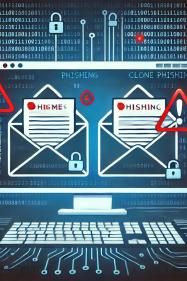Phishing is one of the most prevalent and damaging cyber threats today. Cybercriminals use deceptive messages to trick individuals into revealing sensitive information such as passwords, credit card numbers, and personal data. Recognizing the common indicators of a phishing attempt is key to protecting yourself and your organization. At Arsen, we specialize in awareness training to help employees spot these red flags. Here are the top five indicators of a phishing attempt and how to spot phishing indicators.
1. Suspicious Sender Address
One of the most telling signs of a phishing attempt is an unusual or unfamiliar sender address. Attackers often create email addresses that closely resemble legitimate ones but contain slight alterations, such as misspellings or added numbers.
Example: You receive an email from what appears to be your bank (clone phishing), but the sender's address reads "service@yourbank-secure[.]com" instead of the official "service@yourbank[.]com." Phishers use these small changes to deceive recipients into thinking the message is from a trusted source.
How to Spot It: Always inspect the sender's email address carefully. If it looks unfamiliar or off-brand, it’s likely a phishing attempt.
2. Generic Greetings and Lack of Personalization
Phishing emails typically use generic greetings like "Dear Customer" or "Dear User" rather than addressing you by name. Legitimate companies usually personalize their communication based on information you’ve provided to them.
Example: An email from your "bank" opens with, "Dear Valued Customer," instead of using your full name. This lack of personalization is a common tactic used by cybercriminals who do not have access to specific user information.
How to Spot It: Be wary of messages that use generic greetings or lack other personal details. These are often signs of a mass phishing campaign.
3. Urgent or Threatening Language
Phishing attempts often include alarming language to create a sense of urgency. Phrases like "Your account has been compromised!" or "Immediate action required!" are designed to panic you into responding quickly without considering the authenticity of the message.
Example: "Your bank account has been locked due to suspicious activity. Click here to restore access now!" Scammers use this strategy to pressure you into clicking on malicious links or providing personal information without verifying the source.
How to Spot It: Legitimate companies rarely use threatening or urgent language. If an email or message pressures you to act immediately, it's a red flag.
4. Unusual URLs and Links
A common indicator of a phishing attempt is a link that directs you to an unfamiliar or suspicious URL. Attackers often use URLs that mimic legitimate websites but contain slight variations, such as additional characters or misspellings.
Example: A link in an email claims to take you to your bank's website, but when you hover over the link, you notice it leads to "www[.]yourbank-secure-login[.]com" instead of the official "www[.]yourbank[.]com."
How to Spot It: Hover over links to view their destination before clicking. If the URL seems odd or unrelated to the company's official domain, do not click.
5. Unexpected Attachments or Requests for Personal Information
Phishing emails often contain unexpected attachments or requests for sensitive information. Attachments may contain malware, while requests for personal details like passwords, account numbers, or social security numbers are designed to steal your identity.
Example: An email claims to be from your company's IT department, asking you to download an "important update" attached as a .zip file. Legitimate companies typically do not send unsolicited attachments or ask for sensitive information via email.
How to Spot It: Be cautious of emails asking you to open unexpected attachments or provide personal details. Always verify such requests through official channels before taking action.
Protect Yourself with Awareness
By being aware of these common indicators of a phishing attempt, you can protect your personal and financial information from cyber thieves. Always take a moment to verify the sender, inspect URLs, and question unexpected requests before responding to any message.
At Arsen, we provide next-generation cybersecurity awareness training to empower employees with the knowledge needed to recognize and avoid phishing scams. Remember, vigilance is your best defense against these attacks.
If you want to learn more about how to spot a phishing email, this article may interest you

